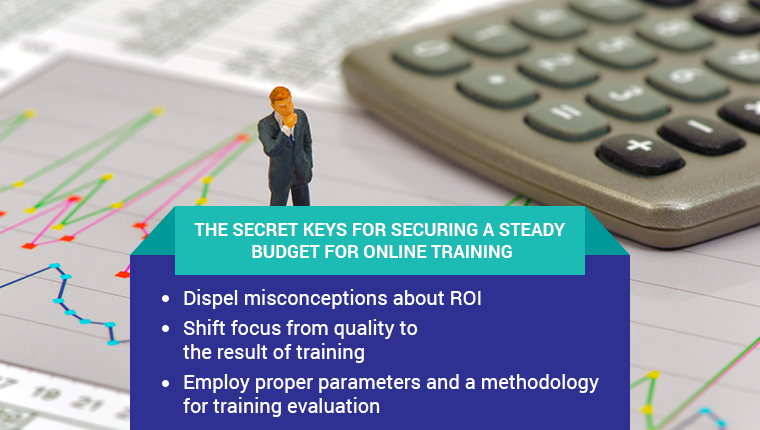Keep Your Online Training Going: 5 Steps to Prove ROI

A professor of mine once told me that being a trainer is at once the world’s coolest and most thankless job. It’s a huge responsibility for you are asked to develop the knowledge of others, to get inside their heads and present a new perspective. Yet people don’t bother to think about the time, effort, and resources at play to make it happen. In corporate online training, most L&D and training managers face something quite similar.
5 Steps to Convince Top Management and Calculate Online Training ROI
- Dispel myths and misconceptions about training and ROI
- Shift focus from quality of training to impact and results
- Plan for a continuous start -to-end ROI calculation
- Set proper KPIs and align instruments to measure training effectiveness
- Adopt a clear training evaluation methodology
They are tasked with building talent and honing employees’ knowledge and skills, but are asked to do so with minimal resources and budget. Since they need to account for every dollar they spend, the best way to ensure a steady funding of online training programs is by proving the Return of Investment (ROI).
But where should you start? How can you make the top management see that digital training programs deliver more value than they cost? Here is a plan toward proving training ROI.
5 Steps to Prove the ROI of Online Training
1. Dispel Myths and Misconceptions about Training and ROI
Business stakeholders and top management understand the value of training, its importance in in enhancing employee skills and bringing value to the organization. They don’t need to be lectured on why online training is important. What they need is the answer to the question, ‘how much value?’
Download this eBook for practical insights on ideas on leveraging learning analytics to maximize training effectiveness.
Herein comes the misconception most people hold about training, that its results are not easily quantifiable. The truth is, calculating the value of online training lies in its impact on organizational growth. It’s not straightforward to determine growth in terms of training alone and several other factors are in the mix, but it can be quantified.
You can create focused groups to observe their behavior before and after training. You can also analyze the difference in skills, productivity, and target deliverables pre and post-training.
Another myth that resonates among many is that calculating ROI and having a fully functional training evaluation is very expensive and needs extensive resource availability. Au contraire, there are inexpensive ways of calculating ROI. And many a times organizations already have data, they just don’t know what to do with it.
Most organizations with eLearning employ a Learning Management System (LMS) or even integrate a Learning Record System (LRS) with an LMS (to support detailed analytics) for tracking and reporting learners’ activities such as course completion rates, average scores, and time taken for the completion of training. Similarly, they employ data visualization and survey software to measure productivity. But more often than not, these reports are analyzed in isolation and then filed away in dusty cabinets. All you need to do is analyze these reports and employ a strategy to calculate the organizational value accounted by training.
2. Shift Focus from Quality of Training to Impact and Results
As training managers, your primary responsibility is to provide employees effective and high-quality training. You’ve trained yourself to judge the value of eLearning in terms of quality and there is no denying its importance. However, when you are trying to convince top management to fund an online training program, you need to adjust your point of view from a learner-centric frame to that of the stakeholders who think in terms of impact on the bottom line.
The value of training for them goes beyond how learners performed in eLearning assessments or how much they enjoyed this new and engaging training module. The real measure of online training starts when learners complete training and start their jobs.
For example, let’s assume you developed online training for sales enablement. Instead of the regular reports, focus on, on-the-job impact. Prepare reports that describe the change in the performance of the sales team, post training. Are they managing to meet more targets? Are they able to close more deals than before? These reports will convince top management in favor of the on-going eLearning program more than anything.
3. Plan for a Continuous Start-to-end ROI Calculation
Calculating the value of online training is not a decision you should make on a whim. It is also not effective if you calculate it once in a blue moon. If you really want to measure how much eLearning is impacting your organizational goals, you will need a steady and streamlined process to track and measure learners’ activities within the online training program, employees’ performance on the job after training, and the overall pace of the organization in meeting its targets.
The plan to calculate ROI should ideally be made alongside the decision to develop online training. This way you can compare the training program with existing ones, justify its development, the effective formats, and more.
Imagine you decide to calculate the ROI of the online sales enablement training after 2 years. Now for some reason you observe the training did not have the desired impact as estimated, or worse the number of deals closed per year remains the same before the training was in place.
Now do you decide to scrape the course or revamp it? If you had a plan of calculating ROI from the beginning, you would have known about the negative impact early-on. What’s more is that if you continually calculate ROI, it will lead you to zeroing in on the actual cause and you can implement immediate corrective actions based on your findings.
4. Set Proper KPIs and Align Instruments to Measure Training Effectiveness
Key Performance Indicators are the parameters on which employee and organizational performance are measured. Setting proper KPIs is very important when it comes down to the evaluation of employee performance post online training. Traditionally, parameters such as the cost of training, passing scores, cost per employee, and hours spend in training were considered KPIs. But to calculate ROI, KPIs need to be more focused on measuring organizational results. Such KPIs will include:
- Targets achieved by individual employees as well as the team – time to proficiency
- Impact on organizational goals and metrics
- Employee engagement
- Stakeholder satisfaction
After setting the parameters for data calculation, you will need to fix the instruments needed to evaluate training. Your LMS is the primary instrument of data capture and reporting. Now that xAPI enabled LMSs are gaining popularity, tracking learning activities will become even more nuanced. To analyze data, you can employ an AI-enabled adaptive engine or data visualization tools such as the GapMinder engine.
5. Adopt a Clear Training Evaluation Methodology
If you talk to any L&D professional about online training evaluation, they most certainly will talk about the Kirkpatrick’s Training Evaluation Model. But when you look carefully, most eLearning programs employ the first two levels of the model and leave out the latter two. The reason being that while the first two levels are training-centric and work within the online learning program, the latter two require resources beyond just eLearning courses and the involvement of other stakeholders as well.
Beyond this model there are less ubiquitous models such as the Kaufman’s Model of Learning Evaluation, the Binkerhoff’s Model of Learning Evaluation, and the Anderson’s Value of Learning Model. While the Kirkpatrick and Kaufman models are designed for quantitative evaluation by measuring actions, Binkerhoff and Anderson models measure opinions and give a qualitative evaluation. For an effective calculation of training impact, you need both qualitative and quantitative evaluation.
Follow these steps for a robust evaluation plan:
- Call for a meeting of all stakeholders involved in the training program.
- Analyze the extent of evaluation needed to calculate the ROI and educate them about the process of evaluation and their role.
- Align all instruments of evaluation such as the LMS or any survey tool with the objectives of each level of evaluation.
- Fix the time, budget, and resources needed for the evaluation.
Wrapping it Up
At the end, all data and calculations are only going to be as good as what you do with it. The ultimate aim of calculating ROI is to prove that training holds considerable impact and has indispensable value. There are new ways of measuring training evaluation using Learning Analytics. And as training managers, it’s your responsibility to ensure training goes on seamlessly to enhance employee as well as organizational value.





